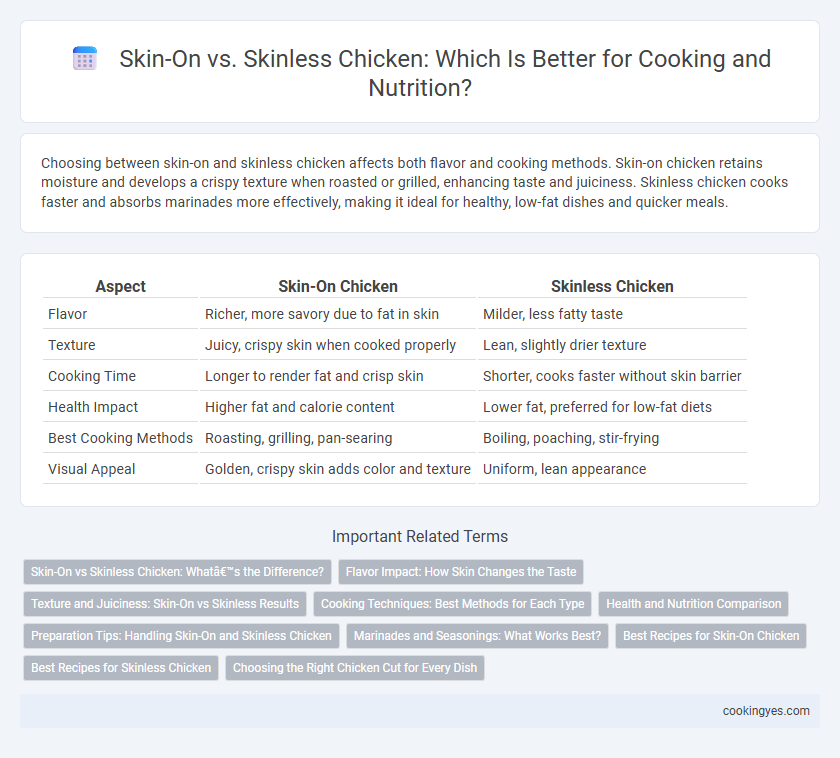Choosing between skin-on and skinless chicken affects both flavor and cooking methods. Skin-on chicken retains moisture and develops a crispy texture when roasted or grilled, enhancing taste and juiciness. Skinless chicken cooks faster and absorbs marinades more effectively, making it ideal for healthy, low-fat dishes and quicker meals.
Table of Comparison
| Aspect | Skin-On Chicken | Skinless Chicken |
|---|---|---|
| Flavor | Richer, more savory due to fat in skin | Milder, less fatty taste |
| Texture | Juicy, crispy skin when cooked properly | Lean, slightly drier texture |
| Cooking Time | Longer to render fat and crisp skin | Shorter, cooks faster without skin barrier |
| Health Impact | Higher fat and calorie content | Lower fat, preferred for low-fat diets |
| Best Cooking Methods | Roasting, grilling, pan-searing | Boiling, poaching, stir-frying |
| Visual Appeal | Golden, crispy skin adds color and texture | Uniform, lean appearance |
Skin-On vs Skinless Chicken: What’s the Difference?
Skin-on chicken retains its natural fat, enhancing flavor and moisture during cooking, making it ideal for roasting and grilling techniques that require crispiness. Skinless chicken is leaner and absorbs marinades more effectively, which suits quicker cooking methods like sauteing and stir-frying for a healthier meal option. The choice between skin-on and skinless chicken impacts texture, taste, and nutritional content, with skin-on typically offering richer flavor and skinless providing lower calorie and fat content.
Flavor Impact: How Skin Changes the Taste
Chicken skin enhances flavor by rendering fat during cooking, creating a crispy texture and rich, savory taste that penetrates the meat. Skin-on chicken retains moisture better, resulting in juicier, more succulent bites compared to skinless cuts. Removing the skin reduces fat content but often leads to a milder, less flavorful chicken experience.
Texture and Juiciness: Skin-On vs Skinless Results
Chicken prepared with the skin on retains more moisture during cooking, resulting in a juicier and more tender texture due to the fat layer that protects the meat. Skinless chicken tends to dry out faster, often yielding a leaner but firmer bite. For recipes emphasizing succulence and richness, skin-on chicken delivers superior results in both texture and juiciness.
Cooking Techniques: Best Methods for Each Type
Skin-on chicken is ideal for roasting and grilling, as the skin crisps up and locks in moisture, enhancing flavor and juiciness. Skinless chicken works best for poaching, sauteing, or stir-frying, where quick cooking preserves tenderness and allows marinades or sauces to infuse the meat. Oven roasting, pan-searing, and smoking techniques maximize the benefits of skin-on chicken's fat content, while steaming and baking suit skinless cuts by retaining lean protein's delicate texture.
Health and Nutrition Comparison
Skin-on chicken contains higher fat content, providing more calories and saturated fats compared to skinless chicken, which is lower in fat and calories, making it a leaner choice for heart health. The skin contains fat-soluble vitamins such as vitamin E and collagen, which contribute to skin elasticity and antioxidant defenses, while skinless chicken offers a higher protein-to-fat ratio beneficial for muscle maintenance and weight management. Choosing skinless chicken aids in reducing saturated fat intake, supporting cardiovascular health, whereas skin-on chicken provides richer flavor and additional nutrients but should be consumed in moderation for balanced nutrition.
Preparation Tips: Handling Skin-On and Skinless Chicken
Handling skin-on chicken requires careful seasoning under the skin to maximize flavor and ensuring the skin crisps properly by patting it dry before cooking. For skinless chicken, marinate for at least 30 minutes to enhance moisture and tenderness during cooking, and avoid overcooking to prevent dryness. Use a meat thermometer to reach an internal temperature of 165degF (74degC) for safe consumption regardless of skin presence.
Marinades and Seasonings: What Works Best?
Skin-on chicken retains moisture and enhances flavor absorption during marination due to the barrier the skin provides, allowing seasonings to penetrate slowly and evenly. Skinless chicken soaks up marinades faster, making it ideal for quick-flavored preparations with bold herbs, spices, and acidic ingredients like citrus or vinegar. Using oil-based marinades with garlic, paprika, and rosemary complements skin-on chicken, while soy sauce, lemon juice, and chili put a punch in skinless chicken dishes.
Best Recipes for Skin-On Chicken
Skin-on chicken enhances flavor and juiciness, making it ideal for roasting, grilling, and pan-searing recipes like crispy roast chicken or spicy grilled thighs. The skin crisps beautifully when cooked at high heat, locking in moisture and enriching the dish with savory fats. Classic recipes such as coq au vin and crispy skin chicken wings benefit significantly from the added texture and taste of skin-on preparation.
Best Recipes for Skinless Chicken
Skinless chicken offers a leaner option ideal for healthy dishes like grilled chicken breast, chicken stir-fry, and chicken salads. Recipes such as lemon herb baked chicken or spicy chicken curry maximize flavor without added fat from the skin. Moist cooking methods like poaching or slow cooking prevent dryness, ensuring tender and flavorful skinless chicken meals.
Choosing the Right Chicken Cut for Every Dish
Skin-on chicken offers extra flavor and moisture, making it ideal for roasting or grilling where a crispy texture is desired. Skinless chicken is leaner and better suited for marinating or quick cooking methods like sauteing and stir-frying. Selecting the right chicken cut depends on the cooking technique and desired flavor profile, with bone-in, skin-on thighs providing juiciness while skinless breasts cater to lighter, healthier recipes.
Skin-on vs Skinless for Chicken Preparation Infographic

 cookingyes.com
cookingyes.com